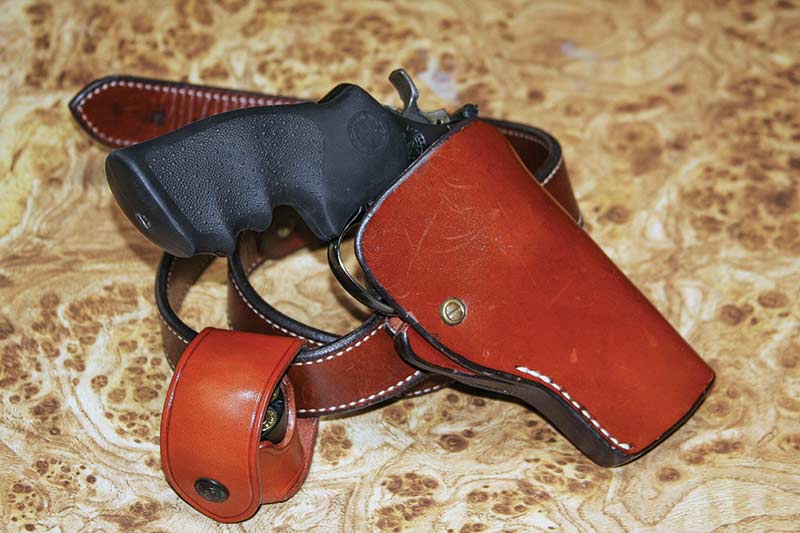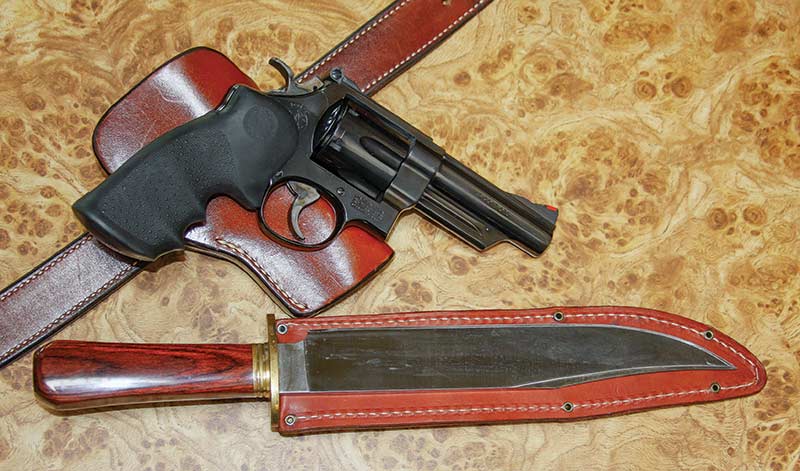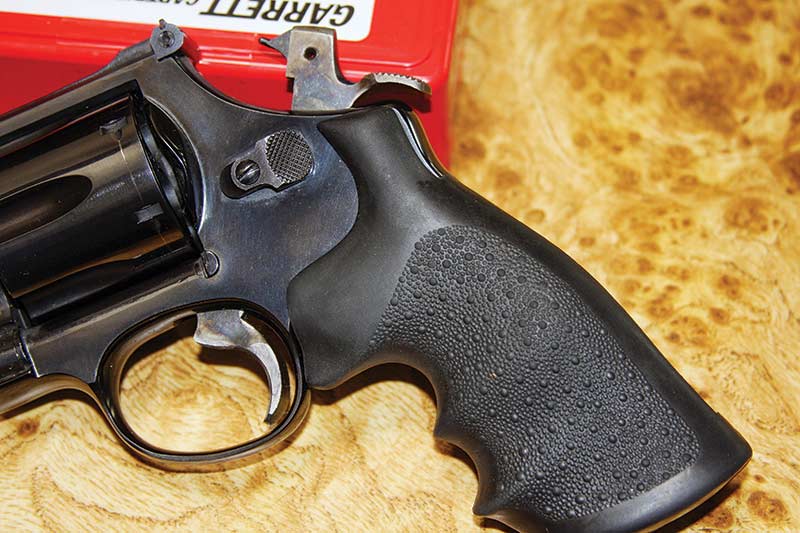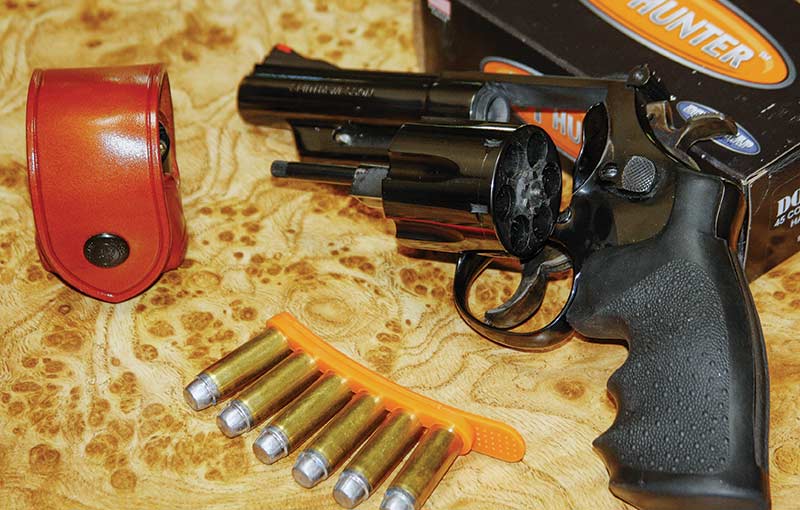While I have long been fascinated with N-Frame Smith & Wesson revolvers, I came to the party only after seeing the movie “Dirty Harry.” Prior to the movie, all my shooting was done single-action, influenced no doubt by having grown up in the 1950s watching cowboy shows on television.
Do You Feel Lucky?
Once bitten by “the most powerful handgun in the world”-bug, I realized double-action revolvers produced outstanding results when first cocked before pressing the trigger. Even with a superb action job, it was difficult to maintain a precise sight picture throughout the long double-action trigger pull of the large-frame Smiths. Much of my handgun silhouette shooting and big game hunting in Colorado and Wyoming during the ’70s and ’80s was done with a 6.5″ barreled Model 29 but always fired single-action.
As the years went by and Father Time reminded me more frequently I wasn’t indestructible, I recalled perhaps the greatest fight-stopping handguns in American history were .45 caliber, not the least of which was the venerable .45 Colt. These were available in N-Frame Smiths and looked exactly like my .44 Mag Model 29s but were easier to handle with factory loads.
Not to sound like a fairy tale, there came a day on one of my frequent visits to the North County Shooting Center in southern California when I saw my future S&W Model 25 with 4″ barrel in the display case. A brief examination of the gun confirmed the finish, timing and double-action trigger pull were excellent.
Negotiations were over in seconds, but of course California required another 10 days to decide I could take the gun home.
Taking Stock
Except for the action job and the Hogue rubber grips, the gun is “as issued” by Smith & Wesson. The Hogue grips are relatively narrow with an open back and finger grooves. The stippled sides provide enhanced controllability for fast follow-up shots. Most importantly, they fit my hand perfectly with the open back allowing proper finger placement on the wide serrated trigger. If I had ordered the gun from the factory, I would have requested the smooth combat trigger but the double-action pull is so smooth I had no trouble maintaining a good sight picture throughout.
The trigger is slightly narrower than the trigger guard, ensuring it can’t catch the edge of the holster when the gun is returned to leather. “Back in the day” when handgun hunters and recreational shooters fired big bore Smiths single-action, wide checkered trigger shoes became popular as they allowed the trigger to be pressed slightly sideways while still causing the hammer to fall. It made things easier for those with smaller hands to reach the trigger and shoot the guns equipped with the oversize walnut target grips. I heard stories of guns firing when being re-holstered, but I never witnessed such an event — perhaps they occurred when someone mistakenly tried to holster a cocked revolver.
Sighting In
The adjustable sights are classic S&W. That’s “classic” mid-20th century, not 19th or early 20th century. The fixed front blade has the orange/red plastic insert for enhanced visibility. The rear sight has a white outline around the notch, can be adjusted for both elevation and windage, and features the long tang mounting into a matching machined slot in the frame’s top strap. Windage and elevation adjustment screws take the same-size screwdriver, something I’ve always appreciated in a gun designed to go afield, not just the range.
The hammer is the old-school wide target spur, aggressively checkered to facilitate manually cocking for single-action fire. On an N-Frame Smith, this is an excellent “win/win” feature. Because it’s not a pocket pistol, you don’t need a reduced size hammer, but when you’re out in winter weather at an informal match or a late fall deer hunt wearing gloves, it’s a real asset.
The firing pin is mounted in the hammer rather than in the frame like the pre-“keyhole in frame” Smith & Wessons. When the trigger is pulled fully to the rear, either double- or single-action, the firing pin protrudes through a small hole in the frame striking the cartridge primer. When the trigger is released, the firing pin retreats/rebounds to a safe position behind the breech face. The firing pin doesn’t actually “float,” but it can move vertically. Spring pressure keeps the firing pin low in the hammer. If for any reason the pin isn’t lined up exactly with the firing pin hole when the hammer falls, the pin strikes an angled ramp in the frame that guides the pin up the ramp to and through the hole and allows it to strike the primer.
I’ve been told a frame-mounted firing pin system is stronger and safer but I’m not sure I buy into this. With the hammer at rest, the vulnerable parts are contained inside the frame, so unless you’re walking around with a cocked revolver, everything is protected. The only advantage I’ve found in a frame-mounted system is it’s easier to block the hammer with your support-hand thumb when decocking the revolver or if a game animal moves after you’ve cocked the gun and you’re waiting briefly for a better shot.
Back To Sights
Let’s talk a bit more about the front sight. The top surface of the orange plastic is smooth, meaning it’s quite reflective in bright sunlight. On testing day, the sun was extremely bright, causing a glare off the top of the insert and making it quite difficult to see exactly where the upper edge of the front sight ended so groups tended to expand vertically. While shooting long-range steel in Colorado on a sunlit day, I sprayed the front sight black to cover the orange ramp. When handgun hunting deer, I prefer having the orange strip visible since the most productive hunting is in the lower light levels of early mornings or late afternoons. In addition, it was likely I would be moving in and out of timber.
In a recent writers’ event at Gunsite Academy, I had a chance to work the Fun House with the Model 25. I went through all the drills with the big Smith & Wesson riding comfortably in a Milt Sparks-style strong-side holster shooting DoubleTap 255-grain hard cast semi-wadcutters. Although we “cleared” the house during the daylight hours, changing light conditions became a decisive factor as we went from the bright sunlight of an Arizona afternoon in July to the deeply shaded areas inside the house. As we grow older, our eyes need more light to see well plus we adjust to changing light conditions less quickly.
At first, there were dark targets I couldn’t identify at all. As my eyes adapted, I could see some targets but was unable to determine whether they were holding weapons or not. Once I could tell whether the intruder was armed or not, the orange front sight came into play and I could see well enough to make a decisive shot. Of course the best answer is “always have a flashlight.”
No Regret
While I’ll admit my purchase of the Model 25 was an act of passion rather than careful planning, I would not be reluctant to carry the big revolver full-time for both self-defense and hunting. Had my “attackers” been made of other than paper and steel, there is no doubt in my mind as to the outcome. I don’t think any handgun caliber has decisively ended as many fights over a 150-year time span as the old .45 Colt and most of those were before we learned the advantages of a large meplat making the initial entry.
Old fashioned — yes. Still effective — heck yes!





